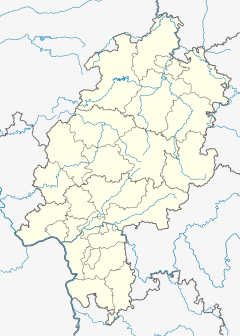On 24 February 2020, a man rammed his car against a crowd at a carnival parade in Volkmarsen, Hesse, Germany, injuring 88 people. In total, 150 people were considered "negatively affected or traumatized by the incident",[1] and it was later described to the courts as a "miracle" that no one had been killed.[2] The attack came only days after a terrorist attack in Hanau.
| Volkmarsen ramming attack | |
|---|---|
| Location | Volkmarsen, Hesse, Germany |
| Coordinates | 51.4098°N 9.1177°E |
| Date | February 24, 2020 |
Attack type | Vehicle-ramming attack |
| Weapons | Mercedes-Benz station wagon |
| Deaths | 0 |
| Injured | 88 |
| Perpetrator | Maurice Pahler |
| Convictions |
|
The perpetrator, 29-year-old Maurice Pahler, was found to have filmed and extensively planned the attack. In 2021, Pahler was sentenced to life in prison for attempted murder with a particular severity of guilt, meaning that he would not be automatically eligible for parole. He refused to give any motive or reasoning for the crime.
Attack
At about 2:45 p.m., a silver Mercedes car was driven first through plastic barricades set up for the parade and then into a crowd at a carnival parade celebrating Rosenmontag in Volkmarsen, Hesse, Germany.[3][4] Eyewitnesses informed BBC News that the driver sped up to attack the civilians, and seemed to target children.[3][4] 88 people were injured, with thirty-five seriously injured.[5][6][4] Twenty of those injured were children, the youngest of whom was a two-year-old.[4]
Once the car initially crashed, bystanders rushed to the car. A woman tried to take the keys from the man, but was choked and had her hair pulled; the suspect tried to restart the car, but three men assaulted the suspect to disable him.[7] 88 people were physically injured in the attack, while 150 in total were "negatively affected or traumatized by the incident".[1]
Aftermath
Hesse authorities cancelled all carnival parades as a precaution that day, and reconvened them on the following morning with enhanced security.[8][3][4] Chancellor Angela Merkel said her thoughts were with the injured and their relatives and thanked the police and medical services.[4]
On the one year anniversary of the attack, an ecumenical service was held in a local Protestant church to remember the victims.[9]
Legal proceedings
The attacker was identified as Maurice Pahler, a 29-year-old local man known to police for crimes including assault.[3][10][11] He was initially detained and arrested on suspicion of attempted homicide. A motive for the attack was not immediately obvious determined as the suspect was said to not be in a fit state of mind to be questioned.[3][4] A second person who filmed the attack was arrested; it is not clear if he was involved in the attack.[12] As of 24 February, Pahler was receiving medical treatment for injuries sustained in the incident but would later be brought before an investigating judge.[8][3][4]
The attack came only days after the terrorist attack in Hanau, and there was initially suspicion as to whether the motive was similar.[5] It was initially reported that the attacker was under the effect of alcohol and drugs, but this was later corrected as false.[13] The court found that he had planned the attack extensively and described it as a "miracle" that no one had been killed.[2] Pahler filmed the attack with a dash-cam he had bought to record the crimes.[1]
Pahler was sentenced to life in prison for attempted murder, causing grievous bodily harm, and dangerous interference with road traffic. He was sentenced with a particular severity of guilt, meaning that he would not be automatically eligible for parole.[1] He was diagnosed with a "severe" personality disorder with narcissistic, paranoid, and schizoid traits, but was found to be fully culpable for his actions.[1][2] He refused to give any motive or reasoning for his attack.[1]
References
Further reading
Wikiwand in your browser!
Seamless Wikipedia browsing. On steroids.
Every time you click a link to Wikipedia, Wiktionary or Wikiquote in your browser's search results, it will show the modern Wikiwand interface.
Wikiwand extension is a five stars, simple, with minimum permission required to keep your browsing private, safe and transparent.

